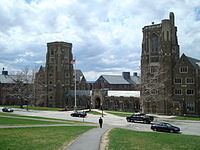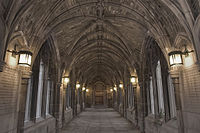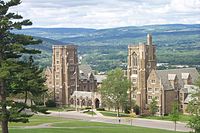- Cornell West Campus
-
West Campus is a residential section of Cornell University's Ithaca, New York campus located west of Libe Slope and between the Fall Creek gorge and the Cascadilla gorge. It now primarily houses transfer students, second year, and upperclassmen. West Campus is currently part of a residential initiative which will result in the adoption of a residential college housing system. By 2009, the revamped West Campus will be organized into five residential colleges.
Contents
History
Grand Terrace
After Risley Hall was designed as a women's residence hall in 1911, work began on the construction of a men's residence hall complex on West Campus. In 1910, Warren Hanning's campus plan had established the site for new halls in the English collegiate gothic style. Trustees George Charles Boldt, Andrew Dickson White, and Robert Henry Treman led a subscription campaign. The site was designed by architect Ralph Adams Cram, who had recently completed the Graduate School at Princeton University. Architectural firm Day & Klauder designed multiple buildings, each housing between 16 and 30 men. Founders Hall was built in 1914 and South Baker Hall was built in 1915.
In the 1920s, West Campus was envisioned as fully Gothic in style, connected to Frederick Law Olmsted's plan of a grand terrace overlooking Lake Cayuga. Rhode Island architect F. Ellis Jackson, class of 1900, expanded this plan to include a memorial to the 264 Cornellians who had died in the First World War. The World War I Memorial group has twin Army and Navy towers with Lyon Hall to the north and McFaddin Hall to the south, both built in 1928. Mennen Hall was built in 1931. Names of those who served are inscribed on plaques between unglazed tracery windows in the cloister. Over the windows are names of battles in which they fought. The names of individual and group donors toward the construction of the halls are inscribed in the tower rooms, Lyon Hall, and over the buildings' entries. The first floor of the War Memorial includes an elaborately decorated octagonal memorial room to the war dead, including a painting by Alison Mason Kingsbury. The upper two floors were designed as the meeting rooms and apartments for the Quill and Dagger honorary society.[1]
Although portions of West Campus were built in the Gothic style, the grand terrace plan was ultimately scrapped. Six dormitories were built in 1953 to accommodate the post-World War II expansion in enrollment. These six brick dormitories were called the "University Halls" to distinguish them from the gothic "Baker Dormitories." In the 1970s and 1980s, five of the individual University Halls were named in honor of various alumni classes which had achieved large donation records. The original Noyes Community Center, which offered dining, recreation and other services to residents of the campus, was constructed in 1966.
Before funding was obtained for either the new North Campus dorms or the West campus replacement dorms, Sheldon Court, Sage Infirmary and Schuyler House were converted into dorms in 1981, and Cascadilla Hall was later renovated.[2]
West Campus Initiative
Cornell had been considering establishing a series of residential colleges since a campus committee chaired by Alain Seznec recommended them in 1969.[3] Although a residential college was established in Risley Hall in 1970, a lack of funding delayed a more widespread implementation. In 1999, then-Cornell president Hunter R. Rawlings III announced a new West Campus Initiative to rebuild large parts of West Campus. With an initial $100 million donation, the project aimed to create a residential college system on West Campus. Furthermore, a new Noyes Recreational Community Center was also proposed to replace the current community center. The project was completed in August 2008.
Residences
House system
As part of the Residential Initiative, the house system aims to create smaller communities enhanced by a relaxed atmosphere to supplement students' academic pursuits. Each residential college is housed in a newly-built main building, and three colleges include surrounding Gothic-styled buildings. Within each main building, each college has its own dining hall. Rooms are divided into hallway-style arrangements and suite-style arrangements. All residents must enroll in the House Choice meal plan, which allows them unlimited meals in their own house dining hall, but limits the number of meals they may take elsewhere. This is similar to the Risley meal plan which has been in effect since 1971. The house system comprises:
- Alice Cook House, founded in 2004. It is named in honor of former faculty member Alice H. Cook.
- Carl Becker House, founded in 2005. It is named in honor of historian Carl L. Becker.
- Hans Bethe House was completed in January 2007. It is named in honor of the Nobel Prize-winning Cornell physicist Hans Bethe.
- William T. Keeton House was completed in August 2008. It is named in honor of esteemed Cornell biology professor William T. Keeton (February 3, 1933 – August 17, 1980).
- Flora Rose House was completed in August 2008. It is named after Flora Rose, founder of the College of Human Ecology.
Baker Dormitories
Known as the Baker Dormitories or recently called The Gothic Halls, these are nine residence halls on West Campus recognizable by their ivy-covered stone walls of local bluestone trimmed in Indiana limestone, reflecting the late Gothic architectural style of Oxford and Cambridge. All nine were named The Baker Dormitories in honor of George Fisher Baker, a New York City banker. They housed both freshmen and upperclass males through the 1970s.
 Closer view of the War Memorial, with Hans Bethe House in the background
Closer view of the War Memorial, with Hans Bethe House in the background
All of the Baker dorms became affiliated with house communities. Boldt Tower, Boldt Hall (Language House), Baker Tower, and North Baker Hall are now part of Alice Cook House. McFaddin Hall will be part of the Hans Bethe House. The others, South Baker Hall, Founders Hall, Mennen Hall, and Lyon Hall, will be part of Flora Rose House.
The halls are currently coeducational except for Lyon Hall (women only), but they are all open only to upperclassmen. Lyon Hall also houses the permanent sanctuary of the Quill and Dagger senior honor society and a war memorial shrine. The rooms are singles or doubles arranged in suites and apartments. The facilities include laundry, kitchens, computer networking, study lounges, and TV/social lounges. Some annual events include drive-in movies on the Tower, Fall trips to hike the gorges, sea kayaking on Cayuga Lake, go-karting, a Winter Semi-formal, a Mardi Gras celebration, trips to the Late Show with David Letterman and an end of the year barbecue.
Class Halls
Known as the University Halls or U-Halls, the Class Halls were originally all-male dormitories built on West Campus in 1953. They were designed by Chapman, Evans & Delehanty and Quinlivan, Pierik & Krause.[4] Although officially denied by Cornell, some claim that when constructed, they were intended to be temporary housing (as evidenced, for example, by the transitory fiberglass showers) until better structures could be built. The six halls were later named for Elmer Sperry (the inventor of the gyroscope)[5] and the Cornell graduating classes of 1917, 1918, 1922, 1926, and 1928.
In 1987, these buildings were gutted and the original aluminum-framed windows replaced with dark-brown metal casings. More study spaces and kitchens were added, and the capacity of each University Hall was reduced.[6]
In 1885, Andrew Dickson White's final presidential report warned the University of the day when "all be hard and dry, [the University]'s buildings mere boxes." Such a description is apt to describe the Class Halls. All were built in a similar box-like fashion, lacking individualizing characteristics and architectural complexity. The interiors were indistinguishable from each other, as well. Although not as clear with the addition of the Noyes Community Center, the Class Halls formed a quadrangle arranged symmetrically along an axis formed by the War Memorial. The Transfer Center, one of two West Campus Program Houses, resided in the Class of 1917 Hall. This Program House, established in 1977, was dissolved in May 2007 when the building was torn down. Between 2003 and 2007, the halls were demolished in favor of larger residential colleges as part of former president Hunter R. Rawlings III's "West Campus Housing Initiative." For many years Sperry Hall (University Hall #6) was also a Program House. The Class of 1926 Hall housed the Just About Music (JAM) Program House.
By 2007, all of the Class Halls had been demolished. In their place, Flora Rose House and William Keeton House dormitories were constructed and finished by the summer of 2008.
Housing selection process
Whereas freshmen are guaranteed housing on North Campus, upperclassmen housing is more complex. Sophomores are guaranteed housing, but seniors and juniors are not. A lottery system is used to randomly allow students who apply to select their residences for the next year. For the residential college dorms, an in-house lottery of current upperclassmen is used to allocate a fixed number of rooms for rising juniors and seniors. Next, the remaining rooms are applied for. The number of senior and junior slots in this pool are determined by the total number of open rooms on West Campus, minus the number of sophomores who applied for West Campus housing. Then, in order of sophomore to senior, the applicants are allowed to select their rooms for the next academic year. Furthermore, students are allowed to block, so that up to five applicants may select adjacent rooms at the same time. Note that a special requirement for blocks of three or more participants is that one person must be assigned a bed in a double or a triple room.
Small Living Units
West Campus includes a number of other student residential structures, including those organized under the Cornell University Residence Plan of 1966, among the following:
University-owned[7]
- 14 South Ave (originally Kappa Alpha Society)
- 112 Edgemoor Lane (upperclassman dormitory; originally Triangle Fraternity)
- 660 Stewart (Cooperative), 660 Stewart Ave
- Chi Phi ("Craigielea," fraternity), 107 Edgemoor Ln
- Delta Kappa Epsilon (fraternity), 13 South Ave
- Delta Tau Delta (fraternity), 104 Mary Anne Wood Dr
- Delta Upsilon (fraternity), 6 South Ave
- Kappa Alpha Theta (sorority), 519 Stewart Ave
- Lambda Upsilon Lambda (fraternity), 722 University Ave
- Phi Gamma Delta ("The Oaks," fraternity), 118 McGraw Pl[8]
- Phi Kappa Psi (fraternity), 525 Stewart Avenue, deliveries to 120 Mary Anne Wood Drive, also known as the Irving Literary Society (Cornell University)
- Psi Upsilon (fraternity), 2 Forest Park Ln
- Sigma Alpha Epsilon ("Hillcrest," fraternity), 101 McGraw Pl
- Sigma Phi (fraternity), 1 Forest Park Ln
- Sigma Phi Epsilon (fraternity), 109 McGraw Pl
- Von Cramm Hall (cooperative), 623 University Ave
- Watermargin (cooperative), 103 McGraw Pl
Private
- Algonquin Lodge (cooperative), 526 Stewart Ave
- Alpha Delta Phi (fraternity), 777 Stewart Ave
- Alpha Sigma Phi ("Rockledge," fraternity), 804 Stewart Ave
- Alpha Tau Omega (fraternity), 625 University Ave
- Alpha Zeta (fraternity), 214 Thurston Ave
- Cayuga Lodge, 630 Stewart Ave
- Center for Jewish Living (formerly Young Israel at Cornell), 106 West Ave
- Kosher Dining Hall (Owned by Center For Jewish Living, Operated by Cornell Dining), 104 West Ave
- Chi Psi (fraternity), 810 University Ave
- Delta Phi ("Llenroc," Ezra Cornell's mansion, fraternity), 100 Cornell Ave
- Lambda Chi Alpha (fraternity), 125 Edgemoor Ln
- Omega Tau Sigma (fraternity), 200 Willard Wy
- Phi Kappa Tau (fraternity), 106 The Knoll
- Phi Sigma Kappa (fraternity), 702 University Ave
- Pi Kappa Alpha (fraternity), 17 South Ave
- Sigma Nu (fraternity), 230 Willard Wy
- Sigma Pi (fraternity), 730 University Ave
- Stewart Little (Cooperative), 211 Stewart Ave
- Telluride House (cooperative), 217 West Ave Ext
- Theta Delta Chi (fraternity), 800 University Ave
Former
- 110 Edgemoor Ln, demolished ("Forest Home," Ezra Cornell's farmhouse; formerly Delta Tau Delta)
- 102 West Ave, demolished (formerly Seal and Serpent fraternity)
Other Buildings
West Campus was served by the Noyes Community Center (formerly the Noyes Student Union) located on Stewart Avenue, centered on the axis of the War Memorial, until the 2006-07 academic year.[9] This building was demolished and has been replaced with the new Noyes Community Recreation Center, which provides indoor athletic facilities located on Campus Road. Academic buildings include: the Kahin Center (1902) designed by William Henry Miller.[10]
Parking
The inadequacy of parking has been the source of controversy and litigation. Alice Cook House was built on the main West Campus parking lot. The University sought to replace the lost parking spaces by paving over the Redbud Woods, located on the gardens of the Treman estate. Conservation advocates sought to protect the area as a Historic District, and advocated underground parking beheath the new West Campus houses. Nonetheless, after much litigation and protests, the University paved the woods as a dormitory parking lot.[11]
References
- ^ 3013-WAR MEMORIAL - Facility Information
- ^ Kriss, Erik (October 2, 1980). "Trustees Will Not Plan To Construct New Dorms For at Least Two Years". Cornell Daily Sun: p. 1. http://cdsun.library.cornell.edu/cgi-bin/newscornell?a=d&srpos=1&cl=search&d=CDS19801002.2.1.6&e=--------20--1----Earl+Schuyler+Flansburgh-all. Retrieved 2010-12-08.
- ^ "Report on the Committee on Residential Colleges". Cornell Chronicle 1 (1): p. 5. September 25, 1969. http://ecommons.cornell.edu/bitstream/1813/5337/35/001_01.pdf. Retrieved 2010-09-18.
- ^ 3089-**SPERRY COMMUNITY - U HALL #6 - Facility Information
- ^ Dear Uncle Ezra - Questions for Thursday, June 15, 1995 - Cornell University
- ^ http://www.fs.cornell.edu/fs/facinfo/fs_facilInfo.cfm?facil_cd=3089 visited 2007-01-07
- ^ http://www.campuslife.cornell.edu/campuslife/housing/undergradhousing.cfm
- ^ http://www.fs.cornell.edu/fs/facinfo/fs_facilInfo.cfm?facil_cd=4732
- ^ 3029-**NOYES COMMUNITY CENTER - Facility Information
- ^ http://www.fs.cornell.edu/fs/facinfo/fs_facilInfo.cfm?facil_cd=4736 retrieve 2007-01-09
- ^ http://www.redbudwoods.org/story.html retrieved 2007-01-08
External links
- West Campus Residential Initiative Alumni Webpage
- Announcement of West Campus Initiative
- West Campus Construction Plans
Categories:- Cornell University campuses
- Cornell University dormitories
- Cornell University buildings
Wikimedia Foundation. 2010.







